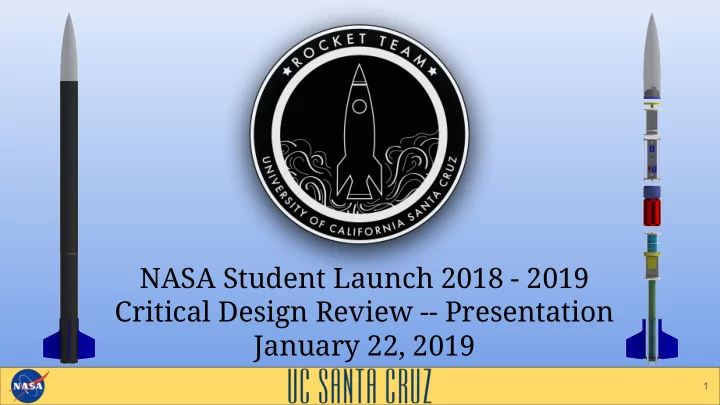

NASA Student Launch 2018 - 2019 Critical Design Review -- Presentation January 22, 2019 1
Key Design Features Carbon Fiber Airframe ● ○ Rolled in house ● Removable Fins As Built CP adjustment ○ ● ADAS (ADaptive Aerobraking System) Adaptive deployment of drag fins ○ ○ Guides vehicle to predetermined altitude via apogee reduction from drag ● Rover Payload Compact rover ○ ○ Object detection system Actuated Landing Correction ○ 2
Vehicle Dimensions Height: 104in Weight: 17.7lbs (no motor) Diameter: 5.46in CG: 62.99in from nose 3
Motor Choice and Vehicle Characteristics Diameter Recovery Final Predicted CG CP Length Mass Vehicle (inches) System (inches) Motor Altitude (in, (in, (inches) (lbs) Material Selection (feet) nose) nose Drogue Main Outer Inner Carbon 80.3 104 5.46 5.36 17.7 L1000 18 60 5280 62.99 Fiber 05 Motor Choice: AeroTech L1000 Motor Weight: 4.84lbs Rail Exit Velocity: 80.1ft/s Thrust to Weight: 12.8 4
Recovery Details Two stage deployment system ● Drogue 18” ● ● Main 60” ● StratoLoggerCF altimeter EasyMini altimeter ● Jolly Logic Chute Release ● ● Eggfinder RX and TX 5
Kinetic Energy and Drift Wind Velocity (in Drift Radius by Drift Radius by Percent KE = ½ mv^2 = 88.19 Joules mph) Hand (ft) OpenRocket (ft) Difference 0 0 0 - mass = 5.154kg 5 159 129 23% Landing velocity = 5.85m/s 10 380 295 29% 15 566 485 17% 20 767 683 12% Landing Kinetic Energy will be below the 100J KE requirement Predicted Drift radius will satisfy the maximum 2,500 foot drift requirement 6
Testing Each component of the rocket will tested thoroughly to ensure performance meets team and NASA standards: ● Software tests for ADAS and Payload: unit and integration tests for deployment, performance, and sensors Ground tests for Payload separation ● ● Airframe stress tests to ensure structural integrity ● Make sure sensors are functioning correctly in recovery module Visual inspections of batteries and sensitive electronics to check for ● potential hazards 7
Subscale Flight Take Me Home Specifications: OD=3.15” weight=4.75kg length=85.5” Aerotech J420 motor Lack of sufficient pressure holes in recovery bay led to noisy/unreasonable data gathered by the internal altimeters (will attempt to fix in future flights) Data that was physically sound agreed very well with our predictions 8
Subscale Flight 9
Payload: Design Overview Systems: ● ○ Soil Collection (Bulldozer design) Drive ○ ○ ODAS (Object Detection and Avoidance) ALC (Actuated Landing Correction) ○ Dimensions ● Rover chassis design ○ Depth: 4.33 inches Width: 2.35 inches ○ ○ Length: 2.6 inches Weight: 15 oz ○ ○ Material: PLA 10
Payload: Integration with Vehicle ● In-Flight Securement ● Shear Pins Safety Tether ● Key + lock design ● 11
Payload: Deployment Black powder charge ● Reverse kill switch ● ● Actuated Landing Correction (ALC) 12
Payload: In Action ODAS Computer vision ● ● Ultrasonic sensor Drive System ● Treads ● Custom 3D printed Chassis Soil Collection ● Bulldozer design 13
Adaptive Aerobraking System (ADAS) Homemade simulation (1D Euler method-based) generates reference trajectory for control of fin deployment to reach target apogee: 1 mile 14
Requirements Verification ● 78 Incomplete: 48.75% ● 24 In Progress: 15% ● 58 Complete: 36.25% 15
Recommend
More recommend